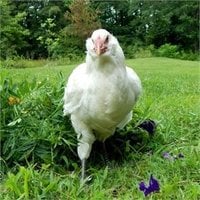General Information
- Breed Purpose
- Egg Layer
- Comb
- Pea
- Broodiness
- Seldom
- Climate Tolerance
- Cold
- Egg Productivity
- High
- Egg Size
- Large
- Egg Color
- Blue
- Breed Temperament
- Unkown
- Breed Colors/Varieties
- White w/ black specks
- Breed Size
- Large Fowl
These start out as yellow chicks and they grow into white hens with black flecks. They typically start laying at the early age of 24 weeks. These hens lay HUGE blue eggs, five to six times per week.

